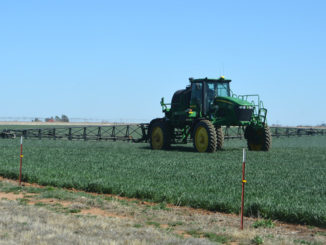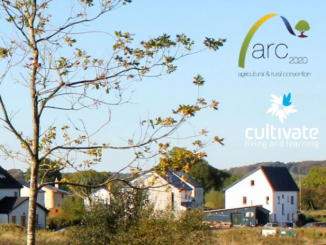
To complete our article series on soil – #SoilMatters – Stuart Meikle has written a comprehensive op-ed style article on the topic. In this, Meikle builds upon his own contribution to the debate – Soil, Ruminants & Sustainable Food.
This new long read initially summarises his existing article, noting the range of areas food production is supposed to sort out, while also emphasising the role of livestock in farming systems. Meikle then focuses on three main areas: society and soil-focused farming; on-farm benefits of soil-focused farming; transitioning to soil-focused farming. This latter section includes seven suggestions for new farm support mechanisms. These seven suggestions focus on both payments and practices, and you can read them below in the excerpt we’ve selected.
You can download the entire piece as a PDF, and read an excerpt below. Enjoy!
PART THREE – MAKING THE TRANSITION TO SOILS-FOCUSED FARMING
By Stuart Meikle
When one looks at what is sustainable production from a soils-first perceptive, one realizes that while climate change as food production is a major source of GHG emissions, focusing on soil restoration offers a multitude of benefits. If there is such a thing as a silver bullet when it comes to how we produce our food, returning our focus to building and maintaining soil fertility is it.
Also, given that a significant proportion of our increased atmospheric carbon has originated from our arable soils, it is where it must return. For many decades now, we have exploited the carbon deposits of millennia, be they from cleared forest or ploughed grassland and that must halt. We have continued to release carbon accumulated in soils and we must stop. Farming now must all be about how to regenerate our soils and accumulate soil-carbon stocks again.
I, like others, have concluded that some populations do need to eat less meat. Simultaneously, it must be about wide access to better quality meat and dairy produce. And by better one means its eating and nutritional qualities, ethical and rural-society-supporting properties, and the way its production delivers for the environment while regenerating and maintaining our soils.
However, where I differ from others is to say that eating less meat and dairy is not about freeing up the land used for grains to feed livestock so it can grow direct-from-the-plant human foods. It is about using that land, managed within cropping rotations, to graze livestock. In the extreme that we do not consume animal-derived products, we will still have to graze animals to build soil-fertility, such is their importance. There are also vast areas only suited to pastoral systems and there it is about how that land is best managed with livestock. Removing them is not the answer. There are few locations where stockless farming is the most appropriate system and where it is practiced its impact is often severe.
My rational is that it is only by so integrating pasture-reared cattle, sheep, pigs and poultry with food crops that we can efficiently close nutrient cycles and return organic matter and carbon to soils, restore degraded soils and produce nutrient-dense foods for a growing human population [noting that nutrient density is about food transport efficiency and our nutrition and health]. Categorically, food and farming must be foremost about soil restoration and maintaining soil fertility. The alternative is to rely on ‘synthetic’ foods that may yield unknown consequences for health and resource-usage.
One can say that our food systems are facing the most complex array of problems in human history. There will be further global population growth, but the problems are such that intensifying current food production systems will not work. In too many ways their resilience is already failing. It is also extraordinary that population growth is cited as a reason to intensify production in land-limited regions while land-rich countries have failing food systems, often due to endemic corruption. Feeding the World in 2050 is about resolving the latter, not further stressing the environments of the former. Of course, if one ignores many of the externalities, the intensification option can look attractive.
Nevertheless, the magnitude of the difficulties only truly come into focus when one accepts that soil degradation and loss is so great that their future productive life can now be measured in decades. Thus, ‘crisis’ is a major understatement for what will face the younger humans who are already alive today. Tinkering around the edges is no longer an option, we must change significantly and change swiftly. If not our children and grandchildren face a bleak future. As for us of the older generations, we must face up to the responsibility of repairing our damaged food systems now, not later. And for that, we must start with prioritising the fertility of the soils and the health of all that live within them.
1. Support for building robust, soil-first food systems
Implementing major change will incur significant costs to food producers. Within a European context, support is provided to the primary producers, often to the extent that it is the main provider net farm income. It is not an acceptable position, but it exists because prices have moved towards ‘global’ levels, albeit the products of concern are entirely produced and sold within a local or national market, while farms frequently remain small and cost inefficient. As the Sustainable Food Trust, recently pointed out, the externalities of food production are massive and not reflected in retail prices. Hence, cheap food on a total cost basis is a myth. Food is also not just about cost, it is more complex, and consumers can value numerous quality characteristics; locally produced and traceable being but two.
It is therefore reasonable to assume that taxpayers will retain a willingness to support farmers but in doing so they will demand a greater say in the production methods employed. Food security is often given as a justification for on-going farm support, but it is fatuitous argument if it is not recognized that support must be exchanged for the restoration of soils and the maintenance of soil fertility.
For farming to return a soil-fertility-first approach to food production will inevitably mean change. It will mean less single farm enterprise specialization and more ‘mixed’ farming. It will mean returning farm animals to land that may not have carried stock for half a century or more. It will be a radical change and have cost implications. The multiple benefits from doing so should, nonetheless, outweigh the costs. If one accepts the necessity for change, farm support needs re-focusing to encourage it.
We must not, nevertheless, replace one support system with another. A failure would be to change farming systems and remain in a position where annual payments are still needed to provide farmers and growers with sufficient for farm household income. Change needs to be comprehensive, but it must occur alongside reformed and improved linkages between the consumer and primary producer.
There is the argument that public goods should be paid for. We must, nonetheless, reach a point where soil maintenance, biodiversity preservation and water catchment are integral to normal farming system rather considered a public service. There will be exceptions to the rule in terms of public access, landscape management and specific, ‘hot-spot’ ecologically-focused schemes, but we should ensure that into the longer-term, markets reward farmers; albeit that there will have to be a transitionary period to get there. Agricultural policy must now be about managing that transition.
2. We must focus upon change and not the status quo
The Common Agricultural Policy is due for another reform and the UK is going its own way and will create its own farming and food policy. Will either deliver much-needed radical change? It is unlikely due to the lobbying power of many involved. There are also vested interests that would prefer the status quo. The position of some farming lobbies is an interesting one; why do they so voraciously support the continuation of a system that apparently does not deliver a sustainable farm income for the farmers that pay them? Is it just that they lack the vision to see better, viable alternatives?
The fear is that CAP reform and/or the development of new UK policy will neither recognize the need for change or introduce radical enough mechanisms to support farming through necessary change.
The car industry is now providing an example of the change required with its intended departure from the internal combustion engine to electric and/or fuel cells. It has reached a point where Society and its consumers are demanding change. The difference between car manufacturing and farming is one of scale and that individual farmers are unlikely to be adequately capitalized to handle such change. Hence, within the farming-food mix is the consumer-taxpayer. Eventually, it will be their combined purchasing and lobbying power that will be the dictating force behind policy. It is only a case of when. Farmers must prepare for change, embrace it, and ask for support to make the transitions needed.
Four principles should govern future payments made to farming and rural communities under a new food, farm and rural policy. They are, a) that they compensate farmers and land managers for income forgone, b) they reward the same for achieving public-interest-targeted actions, c) they must be tapered to allow business adjustment during transition periods, and d) they offer capital investments grants to encourage policy-identified changes to both farming systems and food supply chains.
A key objective must be to break the linkage between food production and annual payments. Farm incomes must be derived from the consumer and route-to-market mechanisms must operate to transfer a fair proportion of the retail price to the farmer. It is not about under-writing the uneconomic but ensuring that farmers who produce what consumers demand are rewarded for doing so. It is about ensuring that trading-relationship imbalances within the food system do not distort the connection between resource usage and investment and the financial rewards.
In recent decades, farmers have seen their influence over their routes to market dramatically eroded. Policy and support must be focused upon redressing this. While many farming organisations continue to resist any erosion of direct support, it is their failure to protect the farmers interests within their routes to market that has led to the farmers’ dependency on production-support payments. If we are to demand that farm and food systems change, we must also support route-to-market change. It is the ‘new’ consumers desire for local, traceable, eco and animal-friendly food that now also provides the opportunity for reconnecting the farmer with the consumer and the consumer with the farmer.
3. What should new farming support mechanisms look like
To conclude this document, seven suggestions for farming support mechanisms are suggested. To facilitate change, the emphasis must move from annual payments to providing capital grants to support system changes. These could be in the form of grants for initial capital investments and capital allowances for asset renewal. Such a methodology would promote changes that directly focus upon policy-desired deliverables whilst not putting in place any long-term food production subsidies.
Further, capital grant availability must not be limited to farming and it should be accessible to those seeking to remove impediments to change within routes to market. It should also be available to those who wish to create products that are defined by how they are produced as it is only with such products that farmers and supply-chain intermediaries can fairly and honestly communicate with consumers.
After decades of support payments, it will be necessary to operate transitionary periods. Anything else will not be ‘politically’ acceptable. Into the long-term, annual payments must only relate to delivering environmentally-linked services like, for example, climate-change mitigation, rainwater catchment, biodiversity enhancement or landscape preservation. They must not be linked to food production.
Going forwards, direct farming-related payments must encourage specific farming-system change. These must be tapered as the changes must, in time, substitute one productive farming system for another. The market should provide the returns needed to reward the farmer for adopting changes.
Conversion-to-organic-farming payments provide an example. They offer ‘compensation’ for yield falls during conversion and because produce cannot be sold as ‘organic’ until conversion is complete. The rational used for organic farming should be used with, for example, adopting zero-tillage arable, integrating livestock into arable rotations, or establishing silvo-pastoral or agroecological systems.
The following provides a few specific pointers, but they are only a few as, like changing the food system itself, policy and policy mechanisms will be complicated. The whole must be amalgam of policies to address the many issues. It cannot be simplified even if the actual final objectives are.
Stuart Meikle’s seven suggestions for farm support mechanisms – A to G!
A) Transitionary annual payments schemes;
B) Reintroducing mixed, rotational farming;
C) Housing farm animals to create products;
D) Providing capital re-investment grant aid;
E) Scrappage schemes for dated technology;
F) Support to modify existing supply-chains;
G) Farm-focused research and development.
a) Transitionary annual payments schemes
Farming-system change will take time and incurs costs. It is why countries where the belief in organic farming is greatest are willing to support farmers through that transitionary period. Such schemes now need to extend beyond organic to encompass regenerative-agriculture, agro-ecology, soil-first farming etc. It will be difficult in that some countries are still reluctant to support organic even though it is now a well-established and widely recognized approach to food production. That must change.
In theory, one could say that the future is ‘organic’. That will, however, stifle innovation. It is also unlikely that organic as it is now defined is the complete package. Nevertheless, it will be challenging to develop and define farming systems that can be packaged so that the consumer at the time of product purchase can identify with the farming-system objectives. It will be difficult to create complex food-production solutions while defining them in a consumer-friendly way. It has been achieved with organic. so new farmer-consumer connections must not now be limited by a lack of ambition.
Transitionary changeover payments should be calculated according to the likely impact on production during any transition period when output is depressed and when there is no likelihood that the market will pay any ‘new-farming-system’ premium. Payments should be tapered and short to medium term.
b) Reintroducing mixed, rotational farming
Reintroducing grazed farm animals to arable land [from where directly-consumed plant-derived food products come] will, in many countries, be the single greatest change that has occurred in agriculture for a century. Such a change will require capital investment; especially so when grazed animals must be housed in GHG-emissions-minimizing winter accommodation. Technologies will play a part in reducing fencing costs, but drinking water is always needed. There will also be innovative solutions to animal ownership, land access and stock management but, whatever, the capital costs will be high.
The change will also have local employment implications. Farm animals require people and often the agricultural housing stock in arable regions has long since been sold off. Hence, policy changes must go beyond food and farming to include local planning and housing policy. A focus on ‘better’, higher-value animal-products should offer an often-long-awaited opportunity for rural regeneration.
Realizing a sustainable food system is not only going to be about policy changes at government level. It will require a mindset change by the many whose policies have been to persuade people that they must stop consuming animal-derived products. That manmade alternatives are not biodegradable often seems to go unnoticed. Thankfully, many environmental and food campaigners are now aware that it is about ‘regenerative agriculture’ and that it is about being highly selective when choosing which animal-derived products to purchase. We must, however, focus on creating policy mechanisms that make ‘better’ affordable to all and not just to the wealthier few. Beyond that there now needs to be a strong educational message about the importance of grazing livestock to soils regeneration, soil fertility, nutrition, healthcare, re-establishing biodiversity to farmland, and farm-animal welfare.
c) Housing farm animals to create products
Temperate locations where farm animals can be outwintered are few. It is almost inevitable that stock will have to be housed for a winter period; thus, incurring capital costs and the problem of ‘waste’ storage and handling. The term ‘waste’ is, of course incorrect in that farm manures, correctly used, are a valuable fertilizer. When it comes to their application to agricultural soils, it is likely that jury will be sitting on whether the spreading of unprocessed manures and slurry is beneficial or detrimental. Will their plant nutritional properties outweigh any damage they do to the soil biome? If it is the latter, there will be major problems for the entire livestock industry but especially for ‘industrial-scale’, year-around confined operations. If we find that we must soon look at livestock housing from a soils-first perspective, we may be staring at some of the largest investment needs in farming history.
Manures and slurry are currently looked upon as plant-nutrient sources. Their value as such partially offsets the costs of storing and handling. Well-rotted farmyard manure and composts are, however, also valuable as sources of organic materials for soil conditioning. Where livestock are reintroduced to arable regions, it is likely that housing will favour composting barns over slurry systems. They may also eventually become the default build in traditional livestock areas. In addition to compost, biogas systems must become the norm where livestock are housed, along with solar panels on the roof.
D. Providing capital re-investment grant aid
Governments must encourage change by offering precisely-targeted investment grants. If farming is to help mitigate climate change, restore soils and the natural environment, improve animal welfare and reduce its reliance on production techniques that are losing their efficacy, major change over the coming years is inevitable. It means investment and support should encourage and facilitate such.
Governments should choose to offer capital investment grants [as opposed to open-ended annual payments]. As with the proposal for tapered, transitionary payments, capital grant provision is about encouraging and supporting system change, not replacing one set of direct payments with another.
After years of over-complicating grant provision, new grant schemes must be simple and efficient. We must move away from over-complicated, often business plan and cash-flow-based grant applications to schemes where those who offer the grants know what farmers need and what the typical costs are. Grant scheme management must shift to on-the-ground monitoring of expenditures and asset usage.
As mentioned below, ensuring that we have robust and resilient food systems means that farms must be economically sustainable. In light of recent experience, that will mean route-to-market investment in, for example, local, small-scale abattoirs to ensure that farmers and consumers have greater choice. Hence, capital grant provision should support both on-farm and route-to-market investment.
E) Scrappage schemes for dated technology
Scrappage schemes have become common place in the automotive sector as governments seek to see highly-polluting internal combustion engines with new generations of less polluting ones. One can imagine that when ‘zero-emission’ cars become widely available, such schemes will usher in the changeover. More so in urban areas. if we wish to see major system changes in agriculture, we should also consider a similar approach to aid the removal of highly polluting farming systems.
Adopting change will mean that the existing technologies will be obsolete sooner than anticipated. As an illustration, the widespread adoption of minimal and zero tillage will bring to end centuries of using deep cultivations. Such a change will have consequences for machinery manufacturers and farmers. There has also been massive investment in confined animal systems that Society may choose to make obsolete sooner rather than later. It will largely depend on lead-in time, but when swifter change is demanded the stronger is the case for introducing a scrappage schemes to help facilitate change.
F) Support to modify existing supply-chains
A central objective of any policy reform must be to avoid a repetition of a situation whereby annual production support becomes the norm. Annual support will be necessary where the provision of public goods occurs but that must occur independently of food production. That said, the quid pro quo of such a major change must be that food supply chains are capable of effectively linking the consumer to the farmer when it comes to rewarding the farmer for providing multi-characteristic foods that deliver upon multiple objectives. Inevitably, producer groups, co-operatives and designated-origin schemes will have to be revisited to provide effective supply-chain entities and linkage mechanisms.
There are occasional attempts to ensure that food supply chains are fair and equitable. Indeed, the EC is currently voicing its intention to regulate upon trading practices. Will that, however, be sufficient? Recent decades have seen post-farm gate consolidation to the degree that there is a major trading imbalance between retailer and farmer. The consequences have been inevitable. It is not realistic to think that regulation can now bring about great change. From here on it is about supporting farmers and producers to introduce new routes to markets over which they have greater control. Inevitably they will be small-scale and local, but it is about ushering in more choice for farmer and consumer.
G) Farm-focused research and development
British farming’s history is one of innovation. It was from the county of Norfolk that the four-course cropping rotation came, a system that was to underpin soil-fertility-focused farming for generations.
Over the last half-a century, research and development has moved away from the farm. As it has become more science-based its costs have risen and its very nature has taken innovation out of the hands of the farmer and into the hands of the scientist. A consequence of the later 20th Century agricultural revolution is farming that is now reliant on external research and bought-in inputs. It does not appear to have delivered in terms of farm incomes. Its resilience is now also in question.
As farming has become more reliant on technologies manufactured outside the farm-gate, we are discovering that many have high natural resource and environmental costs. The twin problems of these costs and efficacy decline means that food systems must become less reliant on off-farm technical solutions. This fits with a soils-first, husbandry-orientated approach to food production.
Recently, husbandry-focused research has been limited largely to the organic domain. There is also a body of non-mainstream research which has focused on alternative grassland management, carbon sequestration and soil regeneration. Farmers have also certainly not given up their own informal on-farm research. Sadly, there is often little financial incentive for agri-input suppliers to get involved with such work, thus little is being done. The question of who funds research therefore must be revisited. Simply, a future robust and resilient food system needs extensive public funding of farming research.
Reducing farming’s reliance on the present suite of technologies does not mean turning away from innovation and technology. For example, precision farming techniques will reduce nitrogen fertiliser and pesticide usage and plant breeding will have no less a role going forwards than now. We must, however, again realize that technology plays a subsidiary role to farm management and not vice versa.
——————–
Below are all articles in the soil series #SoilMatters
#SoilMatters part 6 | What do we want of our soil? And how do we get it?
#SoilMatters Part 5 | Stuart Meikle on Soil, Ruminants & Sustainable Food
#SoilMatters part 4 | What do we really lose, when we change how land is used?
#SoilMatters Part 3 | Soil, Carbon and Policy – where now for 4p1000?
#SoilMatters part 2 | Mario Catizzone and Sustainable Soil Management
#SoilMatters | Part 1: Andrea Beste on humus, soil structures & the limits of no-till





